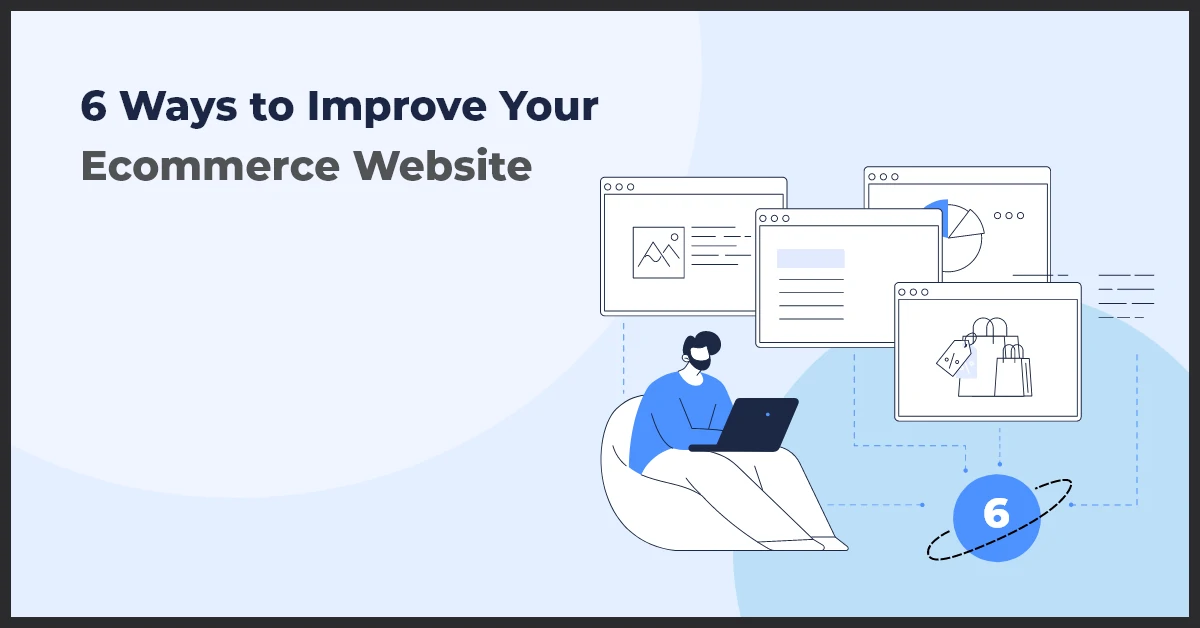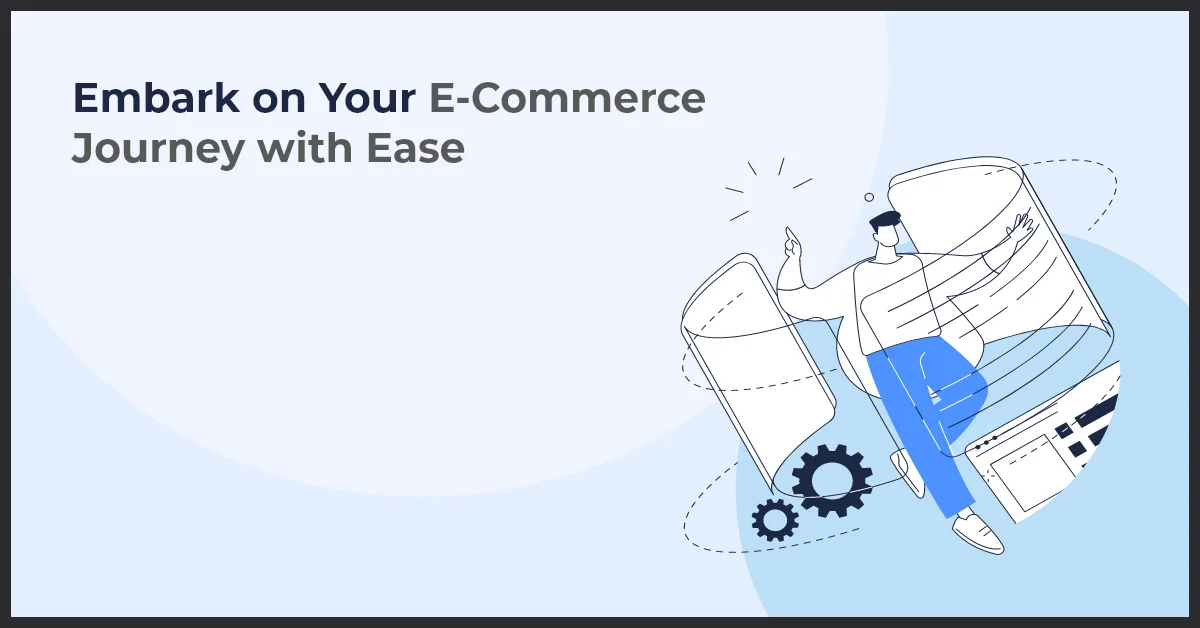How to Improve Your Ecommerce Website

Published on: March 9, 2021
Updated on: June 26, 2024
1745 Views
- Ecommerce
22 min read
Looking for the six infinity stones to improve the performance of your ecommerce website in just a snap? But there is no shortcut to success, eh?
So let’s forget the ‘Thanos’ way of doing things, and discuss the tips and tricks that will take a little time but help you scale your ecommerce business eventually.
When we say ecommerce, what generally clicks is the big names such as Amazon, Flipkart, and eBay. Regardless, we must realize that the ecommerce industry has largely evolved in the last few years. Today, almost every vendor or business performs at least some if not all transactions online.
With the consumers religiously relying on online purchasing now, it is estimated that 95% of the purchases will be made online by 2040. In the year 2017, ecommerce was responsible for $2.3 trillion in sales which is expected to double to $4.5 trillion by the end of 2021. And that’s precisely why you must optimize your ecommerce website, to improve its efficiency and scalability.
Now for the best ways to improve your ecommerce website performance, check out our article below.
Boost Your Online Store Success: Mastering Aesthetics & Functionality to Improve Your Ecommerce Website
Welcome to the digital marketplace revolution, where the secret sauce to a thriving online store blends captivating visuals with seamless functionality. Discover how to strike an impeccable balance by embracing the art of minimalism, ensuring every element on your site serves a purpose. Experience the transformative power of simplicity and clarity that leads to unparalleled customer satisfaction. Learn to harness an intuitive layout and smart navigation to subtly steer customers through a smooth shopping journey. Read on to find out how to elevate the shopping experience, turning visitors into loyal patrons, and browsers into buyers. Let's dive into the world of ecommerce perfection!
Maximize Your Reach: Enhancing Mobile Responsiveness
Welcome to the mobile era! It's no secret that most users today are likely browsing your ecommerce website from their smartphones or tablets. Understanding and implementing a mobile-first approach is not just recommended; it is crucial to your online success. Let's dive into how you can make your ecommerce site shine on smaller screens and keep your mobile audience happy and engaged.
The Importance of a Mobile-First Approach in Today's Market
With more than half of the global web traffic coming from mobile devices, your ecommerce platform can't afford to fall behind. Shoppers appreciate the convenience and flexibility of shopping on the go, which means your site must be optimized for mobile use to meet consumer expectations and stay competitive.
Tips for Ensuring Your Site Performs Well on Different Devices
- Adopt a responsive design: Ensure your website automatically adjusts its layout, images, and functionalities to fit the device it's being viewed on.
- Emphasize touch-friendly navigation: Large buttons, easy-to-click links, and swiping features will make navigation a breeze for your users.
- Compress media files: Larger files can slow down your site, so ensure images and videos are optimized for quick loading without sacrificing quality.
- Test your site: Regularly check your ecommerce site on various devices and browsers to ensure a consistent and smooth user experience.
How Mobile Responsiveness Affects Purchase Decisions
Did you know that a mobile-friendly website can influence buying decisions? Customers often abandon carts or jump to a competitor's site if they encounter hiccups on their mobile devices. A seamless mobile experience can lead to higher conversion rates, increased repeat business, and better customer loyalty. So, put yourself in your customers' shoes and view your mobile site's responsiveness as a pivotal part of your ecommerce success.
By embracing these changes and focusing on mobile responsiveness, you'll not only improve your ecommerce website but also enhance the shopping experience for all your customers, no matter how they choose to browse.
Give Your Ecommerce Site the Speed It Deserves
Ever waited too long for a page to load and just moved on? Your customers are no different. In the fast-paced digital arena, your ecommerce site's speed can make or break the user experience. Quick load times are not just a perk—they're essential for customer retention and conversion.
The Speed-Impact Connection
Did you know that a few extra seconds could cost you a sale? It’s true; the correlation between load speed and customer retention is a tight one. Users expect near-instant page loads, and if your site can't deliver, they'll find one that can.
Analyzing Your Ecommerce Speed
To optimize, you first need to know where you stand. Dive into your website's current performance with tools and techniques designed for ecommerce analysis. Consider using:
- Google PageSpeed Insights for comprehensive performance reports,
- GTmetrix to track loading times and get actionable recommendations, and
- WebPageTest to see how your site performs in different browsers and devices.
Trim the Excess for Faster Performance
Your website’s load speed is often slowed down by code bloat and heavy media files. Here’s how to lighten the load:
- Minimizing code bloat: Keep your HTML, CSS, and JavaScript clean and streamlined. Remove any unnecessary characters, comments, or unused code.
- Optimizing media files: Large images and videos can be the culprits of sluggish sites. Opt for modern formats like WebP for images and H.265 for videos, and use tools to compress files without losing quality.
With these tips in hand, start tuning up your website's engine, because when your pages load faster, your customers smile sooner—and that's what a great ecommerce experience is all about.
Streamlining the Checkout Process: Keep Your Customers Happy
Have you ever been on the verge of purchasing something online, only to be turned off by a confusing and lengthy checkout process? You're not alone. Many potential customers abandon their carts due to checkout complexity. But don't worry—improving your ecommerce website's checkout process can significantly increase conversion rates and enhance customer satisfaction. Let's dive into how you can create a smooth checkout experience for your customers.
Reducing Cart Abandonment with a Simplified Checkout
Cart abandonment is the arch-nemesis of ecommerce success. One of the main reasons shoppers leave without completing their purchase is an overly complicated checkout process. Simplifying this process is crucial. Start by stripping away unnecessary steps and asking for only essential information. The quicker and more straightforward the checkout, the higher the likelihood of securing that sale.
Key Components of an Effective Checkout Page
- Clarity: Ensure every step is clearly labeled and easy to understand.
- Speed: Allow customers to complete their purchase quickly, without any frustrating delays.
- Reassurance: Display security badges and return policies to build trust.
The Role of Guest Checkout Options and Progress Indicators
Forcing shoppers to create an account is a major barrier to completing a purchase. Guest checkout options can help by easing this process for new or one-time customers. Moreover, using progress indicators gives customers a visual representation of how far they've come and how close they are to completing their purchase, preventing confusion and reducing the likelihood of abandonment.
Bring Your Products to Life with Stellar Images and Descriptions
Nothing turns browsers into buyers faster than high-quality visuals and compelling product descriptions. Understand that your online store is a virtual showroom—your images and the supporting text are your frontline sales staff. Let's ensure they're up to the task!
The Impact of Visual Content on Sales and Customer Trust
In the realm of e-commerce, a picture really is worth a thousand words—and quite possibly a thousand dollars. High-resolution, clear images not only boost sales but also build trust with your customers. They want to see every detail, to feel confident about their purchase before they hit 'add to cart'.
Writing Compelling and Informative Product Descriptions
An exceptional product description does more than just describe; it sells. It tells a story, highlighting benefits and features, and answers any questions that photos can't address. Remember, your aim is to replicate an in-store experience as closely as possible.
Best Practices for Photographing Products and Curating Galleries
- Use Natural Light: Whenever possible, photograph your products using natural light as it brings out the true colors and textures.
- Consistency is Key: Maintain a consistent style across all images for a cohesive shopping experience.
- Showcase Multiple Angles: Provide images from various angles to give a full perspective of what you're selling.
- Context Matters: Place your products in a relevant context or setting that potential buyers can relate to.
- Detailed Zoom: Allow customers to zoom in on images for a closer look at fine details and quality.
By focusing on these simple yet effective strategies, you're setting your e-commerce shop up for improved engagement and higher conversion rates. Ready, set, showcase!
Implementing Advanced Search and Filtering Options
Have you ever been lost in a sea of products, struggling to find exactly what you're looking for? It's a common problem that can easily turn shoppers away. But fear not - implementing advanced search and filtering options on your ecommerce website can be the beacon that guides your customers straight to their desired product!
How Advanced Search Improves Customer Experience and Product Discovery
Advanced search functions do more than just look for keywords. They understand the context, comparisons, and even synonyms to help customers find the most relevant products. Imagine a search bar that's a personal shopping assistant - one that knows precisely what your customers are looking for and delivers it on a silver platter. That's the level of service an advanced search can provide, making product discovery a breeze and reducing the chances of customer frustration.
The Benefits of Filtering for Quick and Relevant Product Sorting
With the right filtering options, your clients can sort products by various attributes like size, color, price, or brand. Filters act like a trusty sieve, sifting through the multitude of products and leaving customers with only what they want to see. By simplifying their path to purchase, you're not just selling products; you're selling an easy and enjoyable shopping experience.
Leveraging AI-Based Recommendations for Personalized Experiences
- Personalization is the cornerstone of modern ecommerce, and AI-based recommendations are like the cherry on top. By analyzing past behavior, these intelligent systems can suggest products that your customers didn't even know they needed!
- From "frequently bought together" to "you might also like" suggestions, these AI-powered tips can significantly increase the average order value and customer satisfaction. It's like having a personal shopper for every customer, one that remembers every preference and makes shopping feel like a tailor-made experience.
Utilizing Customer Reviews and Testimonials
Ever wondered what turns a browsing shopper into a loyal customer? The answer often lies in the confidence they gain from other people's experiences. That's where customer reviews and testimonials come into play on your ecommerce website.
Building Trust and Credibility
There's nothing quite like the power of user-generated content to build trust with potential buyers. Reviews and testimonials act as a personal recommendation, a vote of confidence from someone who has already taken the plunge. They provide an authentic voice that speaks volumes about the reliability of your products and your brand.
Strategically Placing Reviews for Maximum Impact
We're not just scattering reviews across the site willy-nilly; we're talking about strategic placement here. Place customer testimonials where they can be most effective: near product descriptions, on the checkout page, or even on the homepage to immediately harness the power of social proof to influence purchase decisions.
Encouraging Post-Purchase Feedback
But wait, the work doesn't stop once the transaction is complete. We want to inspire customers to share their own experiences. Sending a friendly follow-up email encouraging a review, or offering a small reward for leaving feedback can not only improve the quantity of reviews but also deepen customer engagement and loyalty.
- Reviews lend authenticity and depth to product descriptions.
- Testimonials can be the tipping point that nudges a hesitant customer into making a purchase.
- Positive feedback can create a virtuous cycle, spurring more sales and more reviews.
So, let's harness the collective voice of your satisfied customers and put those reviews and testimonials to work, cementing the reputation of your ecommerce website as a trusted, customer-centric marketplace.
Offering Various Payment Options
As the digital marketplace blossoms, the difference between an abandoned cart and a confirmed sale often comes down to convenience. Providing your customers with a variety of payment options is no longer a luxury—it's a necessity. Dive into the world of seamless transactions and discover how expanding your payment methods can significantly improve your e-commerce website.
Catering to a Wider Audience with Multiple Payment Methods
Embracing diversity in payment options is key to reaching a broader customer base. By including traditional methods like credit and debit cards alongside newer forms of payment, such as digital wallets and bank transfers, your e-commerce platform becomes accessible to all, regardless of their preferred payment method.
The Rise of Digital Wallets and Local Payment Trends
The digital wallet revolution is here, and it's reshaping how customers interact with e-commerce platforms. From Apple Pay to Google Wallet, these convenient payment options are gaining traction. Plus, understanding and incorporating local payment trends can tap you into specific markets, catering to regional preferences and boosting global sales.
Ensuring Seamless Transactions to Reduce Checkout Friction
Every extra step in the checkout process is an opportunity for potential customers to second-guess their purchase. It's crucial to ensure that the transition from cart to completed payment is as smooth and intuitive as possible. After all, a frictionless checkout experience leads to a happier customer and a healthier bottom line.
- Streamline your payment page to keep it simple and user-friendly.
- Offer a variety of payment methods to suit different customer needs.
- Ensure payment security to build trust with your clients.
Providing Excellent Customer Service and Support
One key aspect of creating a memorable online shopping experience is ensuring that your customers receive outstanding service and support. Prompt and effective customer service not only addresses immediate concerns but also fosters long-term loyalty to your ecommerce website. Let's explore the compelling ways you can enhance your customer support.
The Importance of Responsive Customer Service
Quick and personalized customer service is more than just solving problems; it's about making your customers feel valued and heard. This can significantly influence how they perceive your brand and can turn one-time shoppers into repeat buyers. A responsive support system is the backbone of customer satisfaction and can have a substantial impact on your business's reputation.
Support Options for Every Customer Need
Offering a variety of support channels ensures that you meet your customers' preferences and availability. Consider the following:
- Live Chat: For real-time assistance and quick questions.
- Email Support: For more detailed inquiries that might require back-and-forth communication.
- FAQs: To help customers find immediate answers to commonly asked questions.
- Phone Support: For a more personal touch and in-depth conversations.
By catering to different communication styles and needs, you maximize your chances of effectively resolving customer issues and building trust.
Follow-up Emails and Satisfaction Surveys
Engagement doesn't end with the sale. Reach out post-purchase with follow-up emails to ensure that your customers are satisfied with their experience. Satisfaction surveys can provide valuable feedback to improve your services and show customers that you value their opinion. These follow-through actions not only enhance the customer experience but also encourage open communication and continual improvement of your ecommerce site.
Boost Your E-commerce Website with SEO Tactics
In a sea of online competition, making your e-commerce website stand out is paramount. Utilizing SEO best practices is not just a buzzword—it's a fundamental strategy for enhancing your website's visibility and driving organic traffic. By understanding and implementing the right SEO tactics, you can significantly improve your e-commerce site's performance in search engine rankings. Let's dive into some actionable steps you can take to optimize your presence online.
Integrating SEO to Drive Organic Traffic to Your E-commerce Site
SEO can seem daunting, but it's essentially about making your website more attractive to search engines and users alike. This means creating content that both resonates with your audience and contains the keywords and phrases they use when searching for products. But it goes beyond that—SEO involves structural and technical elements that help search engines crawl and index your site effectively, which in turn helps potential customers find you.
Conducting Keyword Research Tailored to E-commerce
Recognizing that your e-commerce website needs a specific kind of keyword strategy is the first step towards success. Keyword research for e-commerce means looking for terms that are relevant to your products and your customers' search habits. This entails a thorough analysis of search volume, competition, and user intent. By pinpointing the right keywords, you can craft content that captures the attention of your target audience at various stages of the buying process.
Optimizing Product Pages for Both Search Engines and Users
Product pages are the lifeblood of your e-commerce website, and optimizing them is crucial for higher visibility. This involves more than just incorporating keywords; it's about offering detailed, engaging product descriptions, high-quality images, and clear calls-to-action (CTAs). Providing value in this way not only helps with SEO but also enhances the user experience, encouraging visitors to stay longer, engage with your content, and ultimately, make a purchase.
- Title tags and meta descriptions: Craft compelling and informative title tags and meta descriptions that include key product-specific keywords without exceeding length limitations.
- ALT tags for images: Ensure every image on your product pages includes an ALT tag that describes the image and includes relevant keywords, which aids visually impaired users and contributes to SEO.
- Structured data: Use schema markup to give search engines detailed information about your products, improving the way your pages are represented in search results.
Embracing these SEO best practices will not only boost your e-commerce site's search engine rankings but also provide a more satisfying shopping experience for your customers. Stay ahead of the curve and make SEO an integral part of your ongoing digital strategy.
Leveraging Social Proof and Trust Signals
When online shopping, customers often look for reassurance that they’re making the right choice. Adding social proof and trust signals to your ecommerce website can significantly boost their confidence and your credibility. Let's explore how to harness these powerful tools to improve your ecommerce site.
Enhancing Perceived Trustworthiness with Badges and Certifications
Trust badges and certifications are a quick way for visitors to see that your store is legitimate and secure. Whether it's an SSL certificate, a “Verified by Visa” badge, or a stamp of approval from a well-known industry organization, these visual endorsements tell customers that their transactions are safe with you.
Displaying Social Proof Through User-Counts and Real-Time Purchases
Social proof can be a game-changer for your business. Showcasing the number of users who have purchased a product or seeing a live feed of recent purchases not only creates a buzz around your items but also triggers a psychological response that encourages others to join in. It's the digital equivalent of a busy store, and people are drawn to the crowd.
Using Social Media as a Platform to Showcase Customer Stories
Social media does more than just connect people; it's a space where your customers can become your most influential advocates. Sharing their stories, reviews, and photos with your products not only adds authenticity but also provides a relatable narrative that prospective buyers can trust. So, let's turn those happy customers into your brand ambassadors on social media!
- Posted by customer reviews can create a sense of trust and community, encouraging others to try your products.
- Real-life customer photos and stories give a personal touch that resonates well with new visitors.
- Engaging with customers on these platforms fosters relationships and enhances your brand's personality.
Personalize Like a Pro – Uplift Your E-commerce Game!
Ever felt that thrill when a store just gets you? That's the magic of personalization in e-commerce! Think of it as the digital version of a friendly shopkeeper who knows your name and preferences.
Tailor-made Shopping Experiences Just for You
By crafting personalized content, your ecommerce storefront can mirror a boutique that's uniquely individualized. It starts with small touches, like addressing customers by name or suggesting products based on past purchases, and it can make a tremendous impact on how customers engage with your brand.
Dynamic Content: The Secret to Keeping It Fresh
Dynamic content isn't just a trendy buzzword; it's a game-changer. This approach uses the data footprint of your visitors, like browsing history and preferences, to display content that's as dynamic as their tastes. Whether it's product recommendations or personalized offers, dynamic content helps make shopping experiences feel effortless and thoughtfully curated.
Getting Back on Their Radar: Retargeting Done Right
- Ever window-shopped online and later seen the same product popping up around the web as if it’s calling your name? That’s retargeting! It’s a powerful method to remind potential customers about the items they loved enough to click on, but not quite enough to purchase.
- Retargeting campaigns can attract those almost-customers back to your site, giving your products another chance to win them over. It’s like saying, “Hey, did you forget about me?” without being too pushy.
Personalization isn't just a trend; it's the future of ecommerce. By implementing these personalized techniques, your store is not just selling products; you're providing a unique shopping experience that shoppers will come back for time and again. Go ahead, give your customers that bespoke experience they deserve and watch your ecommerce website flourish!
Analyzing Website Data and User Behavior
Ever wonder what your customers are actually doing on your ecommerce website? Delving into the data might just be the secret sauce for refining the user experience and skyrocketing sales. It's like being a digital detective, unraveling the mysteries of customer interactions to make informed decisions for your online store.
Utilizing Analytics Tools to Gather Insights
First things first—tracking is key. With robust analytics tools, you can monitor every click, scroll, and purchase. This data is a goldmine for understanding where users linger, what they bypass, and where they seem to get stuck. It's not just about numbers; it's about mapping the customer's journey to create a smooth sailing experience from homepage to checkout.
Tracking Key Performance Indicators (KPIs)
Ah, KPIs—those lovable acronyms that every business swears by. Whether it's average session duration, bounce rate, or conversion rate, keeping an eye on these key performance indicators enables you to measure just how engaged users are. Notice a spike in abandoned carts? Maybe it's time to revisit the checkout process. Are users spending less time on the site? It could be a sign to speed up those loading times or make content more captivating.
Adjusting Strategies Based on Data-Driven Decisions
Now, for the grand finale—taking that data and turning it into action. A tweak here, a nudge there; optimizing your ecommerce website based on data-driven decisions can dramatically improve the user experience. See a pattern in which products are flying off the virtual shelves? Make them front and center. Discover that a particular blog post is bringing in a ton of traffic? It's time to craft more content like that.
Remember, your website is always a work in progress, and the best changes are often driven by cold, hard data. So dive into those analytics, listen to what they're telling you, and let the user behavior guide you to ecommerce success.
Take Your Ecommerce to New Heights: The Path Forward
As we've navigated through numerous strategies to improve your ecommerce website, one thing remains crystal clear: an optimized site is no longer a luxury, it's a necessity. The digital landscape is unforgiving, and the margin for error is slim. Your website is the beating heart of your online presence; it's where impressions are formed, decisions are made, and sales are secured.
Crafting A Continuously Evolving Ecommerce Experience
Embracing a holistic approach to enhancements means recognizing that your website is a living entity—always capable of growing, adapting, and evolving. The key lies in the cycle of testing, analyzing, and refining. By engaging in this ongoing process, you cultivate an environment ripe for success, ensuring your site meets and exceeds modern ecommerce trends and customer expectations.
Remember, amidst the pursuit of perfecting your site's design, load speed, or checkout process, the ultimate goal remains steadfast: to amplify the customer journey and drive sales growth. The quality of your content, the strength of your product presentations, and the security of user data—all these facets interlace to form the narrative of your brand and the effectiveness of your ecommerce solution.
Your Next Steps to Ecommerce Mastery
- Audit with intention: Reflect on each component of your ecommerce website as outlined in this post. Where do you excel? Where can you improve?
- Seek professional prowess: Sometimes, an expert touch can make all the difference. If you find yourself in need, don't hesitate to reach out to professional services.
- Share the knowledge: If you’ve found value in these insights, share this post within your network. Collective benefit is a tide that lifts all boats.
Are you ready to elevate your ecommerce site? Start today by auditing your online store against the points we've discussed. If you hit snags or simply want to ensure your website is state-of-the-art, consider enlisting professional assistance. And of course, don't forget to share these gems of wisdom with peers and colleagues. The journey to ecommerce excellence is ongoing, but with the right approach, your business can thrive in the everchanging digital marketplace.
Need help with improving your ecommerce website? Contact Growth Natives!
Looking for one solution to all your ecommerce platform–related problems? Look no further! Our team of ecommerce professionals at Growth Natives is particularly committed to increasing your website performance. From designing a mobile-friendly ecommerce website to the best-in-class checkout process, we have got you covered!
For more information shoot us an email at info@growthnatives.com.
If you believe that there are other important steps that can work wonders for an e-commerce website, fire them up in the comment section below.
And hey, we’d totally appreciate it! 😊



